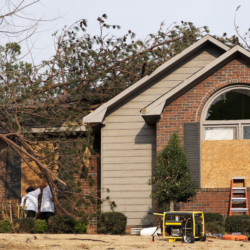Natural disasters, fires, or vandalism can leave your property vulnerable to further damage and intrusion. In such cases, it is important to understand emergency board up procedures to protect and secure your property. This guide walks you through the steps involved in the board up procedure and provides insights into why it’s important.
When faced with a crisis that compromises the structural integrity or security of a property, board up serves as a temporary solution to prevent further damage and safeguard the premises until permanent repairs can be made. By covering openings and vulnerable areas, emergency board up offers protection against weather elements, trespassers, and potential looters.
What is Emergency Board Up?
Emergency board up refers to the process of securing a property by covering windows, doors, and other openings using sturdy materials such as plywood or security panels. This procedure creates a barrier that prevents unauthorized access, reduces the risk of further damage, and maintains the safety of the property.
When is Emergency Board Up Needed?
Emergency board up is typically required in these situations:
1. Natural Disasters
When a property is affected by severe weather events like hurricanes, tornadoes, or floods, windows, doors, and other openings can be damaged or compromised. Boarding up helps lessen the risk of additional water, wind, or debris entering the property.
damaged or compromised. Boarding up helps lessen the risk of additional water, wind, or debris entering the property.
2. Fire Damage
After a fire, windows and doors might be shattered or weakened. Boarding up the affected areas prevents potential theft, weather damage, and unauthorized entry.
3. Vandalism or Break-Ins
In instances where a property has been vandalized, burglarized, or subjected to forced entry, board up is necessary to restore security and protect against further incidents.
4. Structural Damage
When a property suffers structural damage due to accidents, collapses, or earthquakes, board up helps stabilize the structure, minimizes risks, and prevents additional damage from external elements.
Importance of Emergency Board Up
Boarding up holds several crucial benefits for property owners and occupants:
1. Protection Against Weather Elements
By covering broken windows, doors, and openings, emergency board up prevents rain, wind, and other outdoor elements from entering the property. This protection helps prevent water damage, mold growth, and structural deterioration.
2. Enhanced Security
Board up acts as a deterrent against unauthorized access and potential intruders. It reinforces the property’s security and reduces the risk of theft, vandalism, or occupation by squatters.
3. Preservation of Property Value
Taking prompt action to board up a property in an emergency situation can significantly limit the extent of damage. By minimizing destruction, property owners can retain higher property values and reduce repair costs.
4. Safety for Occupants and Workers
The safety of occupants and workers is a top priority during the board up procedure. Implementing safety measures and guidelines helps create a secure environment for everyone involved. By prioritizing safety and maintaining a vigilant approach throughout the process, you can minimize the risk of accidents, injuries, or further damage to people and property.
Steps in the Emergency Board Up Procedure
When it comes to emergency board up, following a systematic approach is essential to ensure effectiveness and efficiency. Here are the steps involved:
1. Assessing the Situation
Before initiating the board up process, assess the extent of the damage and identify the areas that require immediate attention. Evaluate the condition of windows, doors, walls, and other vulnerable points to determine the level of reinforcement needed.
2. Gathering the Necessary Tools and Materials
Prepare the required tools and materials beforehand to streamline the board up procedure. This typically includes plywood boards, nails, screws, drills, measuring tape, and protective gear such as gloves and safety glasses. Ensure that the materials are of high quality and suitable for the specific needs of the property.
3. Securing the Property
Begin by ensuring the safety of all occupants and workers present at the property. Establish clear guidelines and implement safety measures to avoid accidents or injuries during the board up process. Prioritize the well-being of individuals involved.
4. Covering Openings and Vulnerable Areas
Start boarding up the openings and vulnerable areas using the plywood boards. Measure and cut the boards to fit securely over windows, doors, and any other damaged or exposed sections. Attach the boards using nails or screws, making sure they are tightly secured to withstand external forces.
5. Reinforcing Weak Points
In addition to covering openings, reinforce weak points that could potentially compromise the security or integrity of the property. This may involve strengthening door frames, repairing damaged walls, or adding extra support to areas prone to collapse or further damage.
6. Additional Precautions
Consider additional precautions to enhance the effectiveness of the board up. Install temporary security measures such as temporary alarms or surveillance cameras to deter potential intruders. Apply weatherproof sealants or tarps to further protect the property from water infiltration.
7. Hiring Professional Board Up Services
While emergency board up can be performed by property owners, seeking professional board up services is highly recommended. Professional board up companies have the expertise, experience, and specialized equipment to handle emergencies efficiently. They can ensure a thorough and secure board up, minimizing risks and potential complications.
Cost Considerations
The cost of emergency board up can vary depending on factors such as the size of the property, extent of the damage, materials used, and whether professional services are employed. It is crucial to weigh the expenses against the potential risks and damages that may arise if the property is left unprotected.
Conclusion
Understanding the emergency board up procedure is essential for property owners and occupants to protect their assets and ensure the safety of individuals in emergency situations. By promptly implementing board up measures, properties can be secured from further damage, unauthorized access, and the detrimental effects of weather elements. Whether facing natural disasters, fire damage, vandalism, or structural issues, emergency board up serves as a temporary yet vital solution to mitigate risks and preserve the integrity of the property.
FAQs
Q: Can I do the emergency board up myself?
Yes, emergency board up can be performed by property owners. However, it is recommended to seek professional board up services for optimal results and to ensure the safety and effectiveness of the procedure.
Q: How long does the emergency board up process take?
The duration of the emergency board up process depends on factors such as the size of the property, the extent of the damage, and the availability of resources. It can range from a few hours to a couple of days.
Q: Will the boards damage my property?
When installed correctly, boards should not cause damage to your property. However, it’s important to handle the boards with care.



